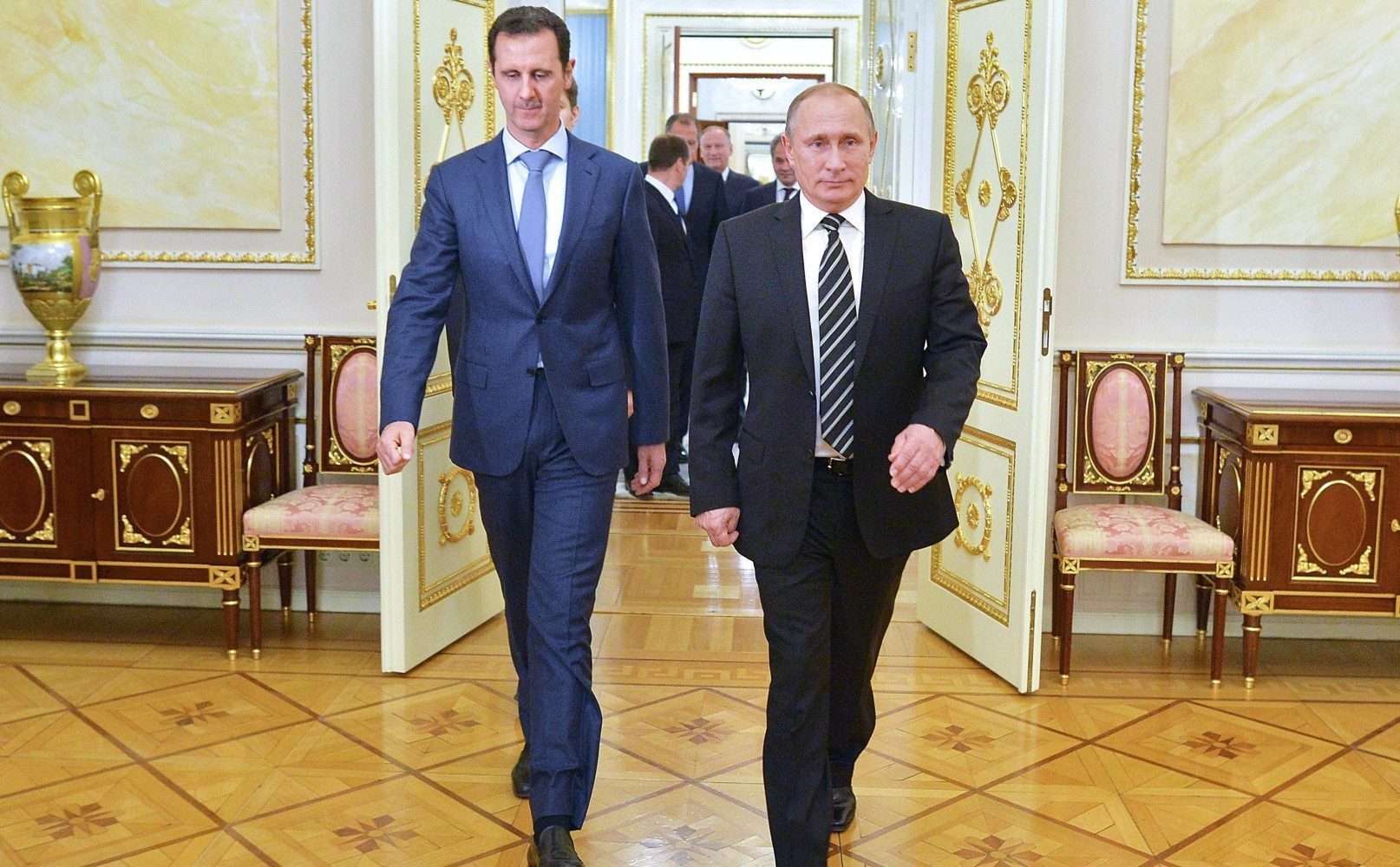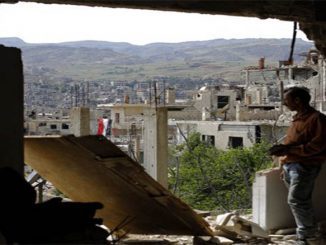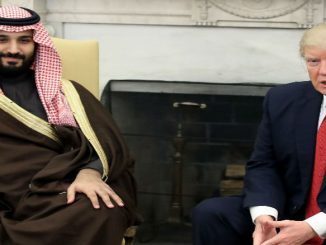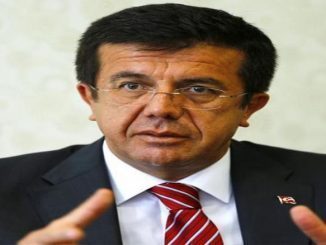
The Syria ceasefire deal unveiled by U.S. Secretary of State John Kerry and his Russian counterpart, Sergey Lavrov, on September 10, is a diplomatic coup for Russia. Moscow has reconfirmed its status as a powerbroker on a par with Washington.
Despite the inherent risks should the cease-fire fall apart, Russia is now in a position to tweak the terms of the agreement to bolster its protégé, President Bashar al-Assad. The Russians view the Kerry-Lavrov deal as a stepping stone to ensuring Assad remains in power with the implicit or explicit blessing of the U.S. and its ally Turkey. The paper looks at how the current diplomatic initiative fits Russia’s strategy of reinserting itself into the Middle East and its relations with key regional players, including Turkey, Iran and Saudi Arabia.
A year after the start of the Russian military operation in Syria, events seem to be stacking up exactly the way Putin and his team want them to. The U.S. accepts Russia as an interlocutor, though probably not as an equal, which is what Moscow would wish. Despite the sanctions on his country, Putin is no longer shunned by Western leaders. In September, he had a chance to talk to the German Chancellor Angela Merkel, President François Hollande of France, UK Prime Minister Theresa May and U.S. President Barack Obama on the sidelines of the G20 Summit in Hangzhou, China. Moscow is suspected of meddling with the forthcoming American presidential elections and blamed for hacking the Democratic National Committee (DNC) emails. The situation in Ukraine remains tense; low-intensity fighting in Donbas continues and Russian authorities allege that Kiev has fomented a terrorist plot in occupied Crimea. But, for all that, Russia and the West are in engagement mode.
The Russian presence in Syria goes a long way to explaining the dual strategy of containment and dialogue pursued by the U.S. and its European allies. It is not that the Obama administration is bullish about the prospects of a grand bargain with Moscow on ending the war. But at this stage, it is not realistic to expect any progress on the ground without a Russian buy-in. Months of negotiations between State Secretary John Kerry and the Russian Foreign Minister Sergey Lavrov are now bearing fruit. On September 10, the pair announced a deal to bring about “a cessation of hostilities”, effective as of the beginning of Eid al-Adha. In case the truce holds for at least a week, the U.S. has also agreed to set up a joint operations’ centre to exchange intelligence information and coordinate airstrikes against radical groups including the so-called Islamic State (ISIS) and Jabhat Fateh al-Sham (JFS, formerly known as Jabhat al-Nusra). To get there, however, the Syrian regime should discontinue its military push against rebel-held areas like eastern Aleppo, ground its aircraft and helicopters which are now showering civilians with barrel bombs and chlorine, and allow the delivery of humanitarian aid. In turn, the American promise to talk anti-Assad militias they support into severing ties with al-Nusra/JFS.
No doubt about it, the U.S.-Russian deal will be fiendishly difficult to implement, if it is possible at all. Can Russia be trusted to rein in Assad and his allies from the Iranian Revolutionary Guards, Hezbollah and motley pro-regime militias? How would the U.S. decouple JFS from other rebel factions, given the critical role the jihadi group played in breaking the regime siege of Aleppo in early August? All through the Geneva talks, scepticism prevailed in Washington D.C. The White House and Defence Secretary Ash Carter are yet to be convinced that Russia can deliver on a durable cease-fire. Even if it does, intelligence-sharing and joint military operations will prove a sticking point. U.S. experts are not brimming with excitement either. The deal Lavrov and Kerry brokered in late February fell apart just weeks after the agreement was signed. Assad launched a new offensive on Aleppo in mid-April, backed by Russian heavy artillery and airstrikes. What the deal did in effect was to provide cover for Putin’s surprise announcement in March that Russia was winding down its operations (as “objectives have been generally accomplished”).
As in the spring, the Russians and/or Assad could use the run-up to the new truce as a smokescreen to capture more territory. (The Syrian leader has vowed to retake all land from “terrorists”.) That is exactly what happened during the Minsk II negotiations in early 2015. Less than a week after the so-called Normandy Four endorsed a ceasefire in Eastern Ukraine on February 12, Moscow-backed separatists took control of the Debaltseve enclave located on a strategically important railway and road junction. As usual, Russia denied direct involvement but the U.S. government, amongst others, claimed that heavy fire from Russian artillery and multiple rocket launchers drove the Ukrainian troops out of the besieged village. Similarly, regime airstrikes went on unabated in the Aleppo and Idlib provinces before the September cease-fire entered into force.
To be sure, there are some cautiously positive assessments too. In some parts of Syria, the deal might empower more mainstream factions of the anti-Assad opposition. In the judgment of Syrian analysts, “in eastern Ghouta, where groups such as Jaish Al Islam have long sought to prevent what is now known as JFS from establishing a foothold for itself, the plan could critically tip the balance in their favor. The same goes for the Southern Front, the coalition of Free Syrian Army groups operating mainly in Deraa.” But again, there is one important caveat: “the plan can only have a lasting, transformative impact on Syria if the U.S. helps the opposition protect itself against the regime, exert political leverage and preserve any gains made against extremists.”
Russia’s Strategy
Yet, beyond allowing for tactical gains on the ground, how does the new diplomatic initiative fit Russian strategy in the Middle East and beyond? Russia intervened in Syria in pursuit of a variety of goals. First and foremost, it wanted to end the isolation resulting from the annexation of Crimea in March, the support for separatists in Eastern Ukraine and the sanctions imposed in response. This objective is, however, largely out of reach. Both the U.S. and the EU look at Russia as an indispensable part of the solution, but have been reluctant to trade co-operation on Syria for concessions over sanctions. They insist that compliance with the Minsk II roadmap, and especially allowing Ukrainian security forces to re-establish control over their external borders with Russia, is asine qua non for any form of relief. Moscow’s second goal, however, seems attainable — that is, reframing the diplomatic relationship with the U.S. as one of equals. Put very simply, as early as August 2013, when the Obama intervention failed to enforce its “red lines” on Syria, Putin stepped into the void to emerge, over time, as a critical powerbroker.
Russia is also determined to prop up the Syrian regime, its most trustworthy ally in the Middle East. By coming to Assad’s rescue it aims at checking the (perceived) Western-exported revolutions, which — in its mind — has had destabilising effects all across the world, including in post-Soviet space. Russia’s alliance with Syria, culminating with the military deployment of September 2015, “reinserted” Moscow into the security politics of the Middle East after a prolonged withdrawal from the region since the 1980s. However, in contrast to the Soviet past, Russia is averse to political and military overstretch. It has consistently tried to keep its commitment limited, avoid mission creep, and keep political options open. Last but not least, the operation in Syria has been a unique opportunity to test the new capabilities of the Russian army, which has been undergoing a process of reform and modernisation since 2008, and to showcase to current and potential customers the advantages of its weapons systems.
How does the current diplomatic initiative fit the overall strategy? There are two aspects to take into account: (1) the fallout for the Assad regime, which is now Moscow’s principal partner in the Middle East; and (2) implications for Russia’s relations with other regional powers, including Turkey, Iran and Saudi Arabia.
Keeping Assad in Power
Moscow sees the deal with the U.S. as yet another step towards the ultimate goal of keeping Bashar al-Assad in power. The proviso that the Syrian Airforce be able to operate in zones controlled by ISIS and JSF legitimizes de facto co-operation with Damascus with Russia as the go-between. It is remarkable how far the U.S. position has evolved over the past year. America’s initial stance was that Assad’s removal was a precondition for any sustainable solution and that, in any event, the president’s days were numbered. As the diplomatic back-and-forth picked up speed following Putin and Obama’s meeting on the margins of the UN General Assembly in September 2015, Kerry came to accept the notion that Assad would be entrusted with a role in the initial stages of the transition at least. “[Departure from power] doesn’t have to be on day one or month one. There is a process by which all the parties have to come together and reach an understanding of how this can best be achieved,” is how he framed the issue. Subsequently, in May 2016, Kerry set August 1 as the target date for the kick-off of the transition process. But his warning that the U.S. could take a “very different track” in case of regime non-compliance did not result in any action. On the contrary, the summer offensive against Aleppo bought the regime even more space for political maneuver, notwithstanding Damascus and its allies’ hitherto failure to capture the beleaguered city.
The next step for Russia is to rebrand Assad from a rogue ruler into a partner in a broad front fighting international jihadism, subject to conditions agreed upon by the U.S. and Russia. Not only would this provide the embattled leader, whose regime was teetering on the edge of collapse just a year ago, a shining symbolic victory, but it would also strengthen his hand in the negotiations on Syria’s future political arrangements, if they are to start in earnest. Russia would have scored a twofold success too: empowering its client and validating its cherished narrative that Islamic extremism and disorder is the ultimate threat. Moscow would be at the centre of a broad-based coalition closing in on the ISIS strongholds of Raqqa and Mosul. And Putin will claim credit for making U.S. policymakers come to their senses, reckon with the harsh realities of Middle Eastern politics, and accept secular autocrats as the lesser evil.
Could the plan work? It depends on how Assad himself moves vis-à-vis the Russians. At this juncture, Russia is highly influential — it provides vital military support and diplomatic cover to the regime. Being fully in charge is a wholly different matter however. As in many cases, it is not clear whether the dog wags the tail or vice versa. The regime has the means to take advantage and thereby torpedo the cease-fire. Rather than control and direct the regime, Russia risks being dragged into Damascus’ campaigns to expand its territorial control, which is a plausible explanation of what happened back in April. Assad’s weakness is actually a source of strength too. Even Russian military experts openly admit that the Syrian Army is in a state of complete disarray – plagued by low morale, dwindling resources, defections and dependent on vital support from Russia, Iran and Hezbollah. Vulnerability and the never-ending danger of a sudden collapse of regime forces keep pulling Russia in, despite its preference to scale down its commitments and avoid putting boots on the ground. Ironically, the Russian contingent has suffered more casualties after Putin announced the end of the operation in March than before. The spectre of unwanted escalation continues to haunt Moscow, but pulling out and abandoning Assad will not work either. This gives the regime enough bargaining chips to keep Russia at the table.
Russia’s Relations with Middle East Powers
The situation in Syria and the two-way diplomacy with the U.S. have numerous repercussions for Russia’s dealings with other major players in the region, notably Turkey, Iran and Saudi Arabia.
From a Russian perspective, the normalisation with Ankara following the freeze caused by the downing of the Su-24 attack aircraft in November, has the potential to transform the formula governing bilateral ties. The old model was based on compartmentalisation: keep disagreements over the Syrian conflict separate from profitable economic relations in order to avoid negative spill-over. But now there is the scope for a positive linkage, where bilateral co-operation narrows the gap on Syria. Even before the failed coup in Turkey, the Russian government-sponsored news agency Sputnik started running pieces suggesting that Moscow and Tehran could help mend fences between Ankara and the Assad regime — all in the name of combating “international terrorism”.
Russia has kept its cool over the Euphrates Shield operation mounted by the Turkish Armed Forces and the Free Syrian Army, as well. The initial statement by the Russian MFA was somewhat alarmist. On August 24, spokeswoman Maria Zakharova voiced concern that the incursion across the border could fuel conflict between Kurds and Arabs. But following Erdogan and Putin’s phone call on August 26 and their meeting at the G20 summit in September, Moscow’s tone calmed down. “Turkey’s operation in Syria was not something unexpected for us. We understood what was going on and where things would lead.” Russia welcomes the routing of ISIS and the closure of the Turkish-Syrian border. It no doubt sees itself as a bridge between Ankara and the Syrian Kurds too. The PYD representative in Moscow, Rodi Osman, who back in February warned Turkey it would enter into a major war against Russia if it crossed into Syria, now praises the Russian role as a mediator. Being on good terms with Turkey, Assad and the PYD at the same time gives Russia an edge over the U.S.
Counterintuitively, Russia’s actions in Syria have led to frictions with Assad’s other principal supporter, Iran. On August 16, the Defence Ministry in Moscow announced that Russian Tu-22M3 long-range bombers and Su-34 tactical bombers had carried out strikes from the Hamadan Airbase against ISIS and JFS targets in the Aleppo, Deir ez-Zor and Idlib governorates. This represented the first time a foreign military had operated out of Iran since the 1979 Islamic Revolution. But soon thereafter the arrangement came apart. Defence Minister Hossein Dehghan openly rebuked Russia for being “discourteous” in revealing the operation to international media. The Iranians had legitimate reasons to be concerned, though it is questionable whether the Russian airforce presence could have been kept secret for long. In addition, the Secretary of Iran’s Supreme National Security Council (SNSC), Ali Shamkhani, confirmed the story indirectly, right at the start, in an interview with the semi-official Fars News Agency. Since mid-August, there have been conflicting messages as to whether the arrangement is still operational or not. Going further back in time, Iranian policy-makers were taken aback when Putin made the dramatic announcement of a pull-back in March. They were not consulted beforehand. The (perceived) U-turn suggested to them that Moscow could easily strike a deal with the U.S. and trade Assad for a role in post-regime Syria. Russia’s relations with the Kurds has been another source of Iranian concern.
Overall, Iran’s ambiguous reaction could be attributed to its unease about Russia’s rising profile in Syria and its implications. The Kerry-Lavrov cease-fire may well bring some of those tensions into the open. Iran’s MFA welcomed the deal, yet warned it should not turn into “an opportunity for transferring militants or sending weapons to terrorists.”
Moscow has stepped up contacts with the Islamic Republic’s adversaries. On September 5, Russia and Saudi Arabia announced the formation of a working group to explore a co-ordinated cap on oil production. However, Putin himself has acknowledged that it would be difficult to bring Iran on board. Multilateral talks collapsed in April amid squabbles between Riyadh and Tehran. If Russia is serious about the Syria peace deal, it might continue to court the Saudis.
Russia is also reaching out to Israel. Moscow is set to host a summit with Israeli Prime Minister Binyamin Netanyahu and Palestinian leader Mahmoud Abbas. While the meeting might well fail to yield substantive results, it will come as yet another diplomatic coup for Putin in his bid to rival the U.S. as a powerbroker in the region. In the words of Zvi Magen, former Israeli ambassador to Moscow, “[The Russians] are eager to become an important player, a big shot in the Middle East. The idea is not to reach any specific results, but it’s good for Russia. They don’t need results. They need the process itself.”
Ironically or not, that statement describes well the Russian attitude to the new “deal” on Syria as well. If, against all odds, a genuine peace process gathers momentum, Moscow will ensure it cements its role as a lead external guarantor of the new political arrangement. If the cease-fire breaks, down it will go on using Syria and growing ties to the Middle East as a magnet to bring the U.S. to the negotiating table. Either way, the gambit will deliver.



